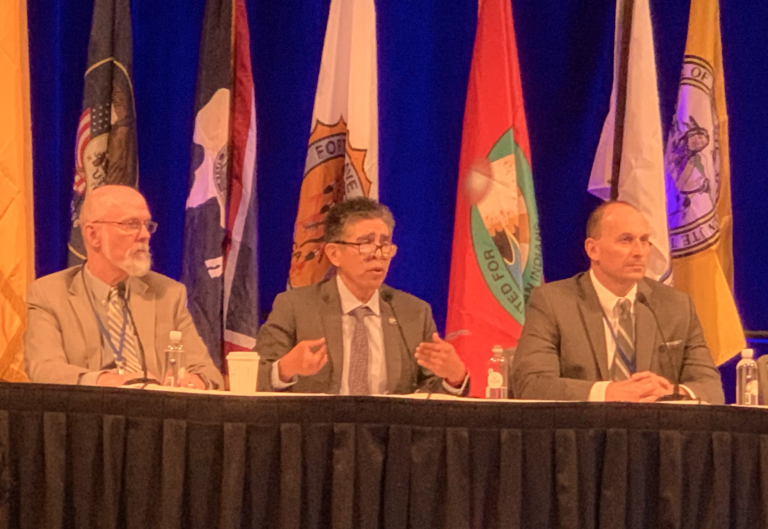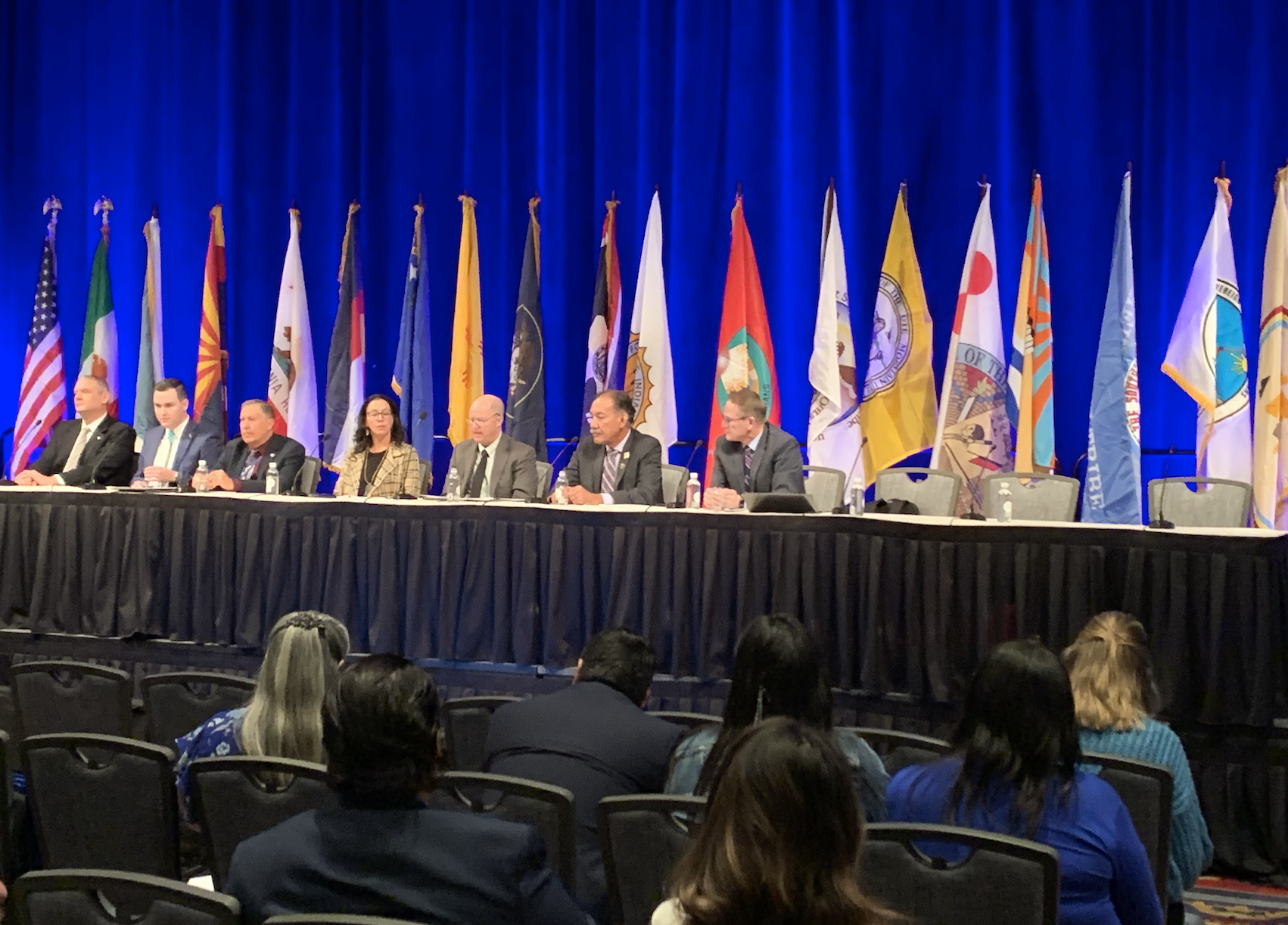The Colorado River has its own version of COP28, and this year it’s fraught with tension and uncertainty.
This week, leaders from the seven Upper and Lower Basin states –– along with the top brass from the Bureau of Reclamation –– convened in Las Vegas for the annual Colorado River Water Users Association Conference.
CRWUA, which began on Wednesday and goes through Friday, is not too different from the jamboree known as COP28, the 28th annual United Nations Climate Change Conference that took place this month in the petrostate of the United Arab Emirates.
Like COP28, there are entourages of powerful people at CRWUA who have a mix of money-driven and public-service interests. These folks represent the institutions that have not yet risen to the occasion, but they are the ones in position –– as state and federal officials, municipal water managers and irrigation districts –– to help achieve a semblance of sustainability on a river system supporting 40 million people, vital ecosystems, and food production.
This small coterie of folks must figure out how to manage the river in a drier, unpredictable future but the current negotiations, just like at COP28, shouldn’t leave us brimming with hope.
The critique of COP28 is that there was no language promising a phase out of fossil fuels by advanced nations. At CRWUA, there were few promises on the table to remediate years of over-use, over-development, and over-reliance on the Colorado River.
The State of Play on the River
The states and federal government are locked into negotiations to hammer out a deal on the Colorado River by the end of 2025.
The tensions are palpable, and top water managers from all seven states admitted as much at a conference session Thursday morning. At this point, the Upper Basin vs Lower Basin political gulf remains wide.
Colorado’s top river official, Becky Mitchell, was strident in her demands and rhetoric about how to solve the problem. She stressed the often-touted notion that the Upper Basin has rights to develop more water. In the same breath, she demanded the Lower Basin fix the structural deficit, the 1.2 million acre foot annual over-commitment in the Lower Basin.
She is not wrong on that front. But implying that Colorado has a right to develop more water is not realistic. There is no more water to develop. She should listen to her own words:
“You don’t have rights to something that’s not there,” she said in relation to the smaller snowpacks and precipitation events in the Rockies.
With recent profiles in major media outlets, many eyes were on the chairman of the Colorado River Board of California and a director for the Imperial Irrigation District, JB Hamby. As a leader at the irrigation district with the largest river entitlement, he has the Sword of Damocles above his head. He agreed that the structural deficit would be fixed by the Lower Basin. But he delivered a very concerted and collected response to Mitchell and the Upper Basin.
“Every user throughout the (Upper and Lower) Basin must contribute,” he said.
The implication of Hamby’s words: The Lower Basin won’t fallow fields, rip out turf, and incentivize conservation just to hand over the savings to the Upper Basin for it to use. Conservation must be for stabilization of the system.
The differences in opinion about Upper and Lower Basin management are not new. But they are coming to a head.
Judges and congressional lawmakers are not the answer to the problems, said Nevada’s representative in negotiations and general manager of the SNWA, John Entsminger.
Compromise among the states, he asserted, is the way forward.
However, as he is wont to do, Entsminger offered sobering remarks about the deal that will be hashed before December 31, 2025.
Don’t expect a panacea, he said, but rather “a messy compromise that will be judged harshly by history.”
What Wasn’t Said
With COP28, there were no promises to end fossil fuel consumption by powerhouse nations at a given date. At CRWUA, there were no promises to prepare for a world where the Colorado River system loses an additional 20% of flows in the coming years (that would be a 40% loss since 2000).
Entsminger was the only person who suggested the Upper Basin ban useless and non-functional turf – as has been done in Vegas. No one talked about insatiable growth in Colorado River dependent cities like LA, Phoenix, Vegas, Denver, Salt Lake, and Albuquerque. No one mentioned the problems with Glen Canyon Dam. Agricultural solutions always come with a host of pricey and litigious problems, which federal money is currently solving.
The Tribes Have a Voice, But They Are Waiting For Their Water Rights
The 30 sovereign nations in the Colorado River Basin have rights to about 3.4 million acre feet of water on the river. An infinitesimal amount is actually being used by tribes. Daryl Vigil, the coordinator for the Colorado River Water and Tribes Initiative, is a constant presence and beacon of hope at CRWUA and other river functions, but even he knows that delivering wet water to native communities will not be easy. Getting a seat at the table is still not surefire.
There is still a need for what he describes as “structural inclusion.”
At CRWUA, the people in power make nice gestures toward the tribes but no one offers to hand the sovereign tribal nations any water or significant compensation for using their senior rights for the past century. Decisions, it seems, are still made behind closed doors where there are no seats for native leaders.

The Cruel Reality of CRWUA and COP28
We couldn’t help but think of the 30 tribal nations with interests on the river in comparison to countries like the Marshall Islands and Tuvalu –– two nations at COP28 imploring large nations to stop burning fossil fuels. Small sovereign nations will pay the price for the actions of the world powers. Some will be drowned by sea level rise. And others will be without any water thanks to the actions of industrialized places.
Climate change is crippling our system. The biggest reservoirs on the Colorado River System are about 34% full. We are careening toward the brink again. The best scientists know that anthropogenic warming has a big role to play in our shrinking river.
Entities in the Upper Basin have made it clear that they want to siphon hundreds of thousands more acre feet from the system for municipal and industrial uses (see our latest mention in Mother Jones). Lower Basin states –– especially representatives from Los Angeles, Las Vegas and Phoenix –– are disinclined to forego much more water use than what’s already been endured in the past few years.
Will the ultimate compromise deliver real reductions in use or upticks in rhetorical justifications?
There’s been a lot of talk at CRWUA, but will there be any meaningful action? Time will soon tell. If COP28 is an indicator, don’t bet on it.

